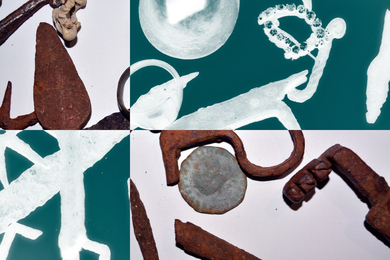“Looking through microscopes has never been my thing,” says Julian Picard.
As a graduate student in the Department of Physics, Picard works with the invisible world of particles and electromagnetic waves every day, yet he is motivated by the goal of creating something very visible, “something you can hold in your hand.” His study of the microwaves that speed from the megawatt gyrotron at MIT’s Plasma Science and Fusion Center (PSFC) could lead the way to smaller and more powerful particle accelerators, the kind of finished product Picard finds rewarding.
Picard became interested in plasma as an undergraduate at the University of Washington in Seattle. His student research at their Advanced Propulsion Laboratory and Space Plasma Simulation Laboratory prepared him for an internship, and later a research engineer position, at Eagle Harbor Technologies. Working there on plasma generation and pulsed power supplies, he admired the way the most experienced scientists seemed to solve problems “intuitively.”
“That was inspiring to me,” he says. “One of the reasons I came back to grad school was to be steeped in something for a long time. After spending so long working hard on something, you start to develop a gut instinct.”
Picard notes it was difficult to find a graduate program that would provide him with a deep physics background, along with the opportunity to apply his understanding to a practical plasma project.
“That is what drives me,” Picard says, “I want to understand how something works well enough to apply it in a new way. To me, it feels vacuous to try to design something without understanding how it works. That’s why I wanted to find a program in physics: I wanted to continue developing my background in basic science, and then be able to apply it to a variety of things.”
He discovered what he wanted at the PSFC in the Plasma Science and Technology Group, headed by Richard Temkin, who introduced him to the center’s megawatt gyrotron, the source of microwaves for a new project to test particle accelerator cavities.
Particle accelerators, besides being essential tools for studying the universe, have practical applications including medical instrument sterilization, computer chip manufacture, material identification and radioisotope production for cancer treatment. While an accelerator typically runs at low frequency (1 gigahertz) with success, researchers have suspected that running it at higher frequencies would allow it to be made smaller and more efficient, improving the convenience and possibly reducing the expense.
Although the PSFC megawatt gyrotron is capable of producing microwaves at the higher frequency of 110 GHz, the length of the pulse would melt any accelerator cavity it passed through. Researchers needed to find a way to shorten that pulse.
In an article for Applied Physics Letters, Picard describes the experimental setup that allowed researchers to “chop” the pulse. The piece received the Outstanding Student Paper Award from the IEEE Nuclear and Plasma Sciences Society at the 2019 Pulsed Power and Plasma Science Conference in June.
To shorten the pulse, PSFC researchers strategically arranged a wafer of silicon in the path of the microwaves. Typically, microwaves would pass straight through this. However, a laser directed onto the wafer creates a type of plasma inside the silicon that will reflect the microwaves for as long as the laser is on. Those reflected high-frequency microwaves can be directed into the accelerator, and the pulse chopped to a manageable length (10 nanoseconds) simply by turning off the laser.
The laser-targeted wafer does not reflect all the microwaves; about 30 percent are absorbed by or pass through the silicon. Picard’s study showed, however, that as the gyrotron power increased toward a megawatt the wafer reflected more. Instead of reflecting 70 percent of the microwaves, it reflected closer to 80 or 85 percent.
“This effect had never been seen before because nobody could test at the higher power levels,” says Picard. “Reflection becomes more efficient at higher powers compared to lower powers. That means there is more power available, so we can test more interesting accelerator structures.”
The PSFC is working with a group from Stanford University that designs accelerator cavities, which can now be tested with the “Megawatt Microwave Pulse Chopper.”
Picard is pleased with the experiment.
“What I’ve really liked about this project is that, at the end of the day, we have a device that makes a short pulse,” he says. “That’s a deliverable. It’s satisfying and motivating.”









